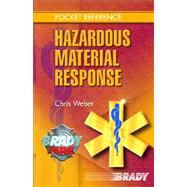
| About the Author | p. xi |
| Acknowledgments | p. xii |
| Preface | p. xiii |
| Managing the Hazardous Materials Response | p. 1 |
| HAZWOPER (29 CFR 1910.120) Requirements | p. 1 |
| Preincident Planning | p. 12 |
| Questions Dispatch Should Ask | p. 13 |
| Rescue and the 3/30 Rule of 2003 | p. 14 |
| Quick Guides | p. 16 |
| Railcar and Cargo Tanker Emergencies | p. 16 |
| Pipeline Emergencies | p. 19 |
| Fixed Storage Tank Emergencies | p. 22 |
| Terrorist and Criminal Emergencies | p. 26 |
| Recognition: Container Shapes and Specifications | p. 29 |
| DOT Tankers | p. 29 |
| Railcar Tanker Specifications and Shapes | p. 36 |
| Railcar Tanker Marking and Stencils | p. 42 |
| Railcar Tanker Construction | p. 44 |
| Pipelines | p. 45 |
| Fixed Storage Tanks | p. 46 |
| Intermodal Containers | p. 51 |
| Nonbulk and Intermediate Bulk Containers | p. 53 |
| Radioactive Packaging | p. 55 |
| Recognition: Marking Systems and Visual Cues | p. 57 |
| DOT Hazard Class System | p. 57 |
| NFPA 704 Marking System | p. 58 |
| Hazardous Materials Identification System (HMIS) | p. 58 |
| Signs of a Clandestine Drug Laboratory | p. 59 |
| Signs of a Terrorist Incident | p. 59 |
| Identification: Shipping Papers and Other Sources of Information | p. 62 |
| DOT Manifest | p. 61 |
| Railcar Consist | p. 62 |
| Airline Waybill | p. 65 |
| Marine Manifest and Bill of Lading | p. 66 |
| Material Safety Data Sheets (MSDS) | p. 67 |
| Pesticide Labels | p. 71 |
| Interview Techniques | p. 72 |
| Identification: Chemical and Physical Properties | p. 74 |
| Definitions of Chemical and Physical Properties | p. 74 |
| Table of Lighter-than-Air Gases | p. 77 |
| Definitions of Toxicological Terms | p. 78 |
| Radiation | p. 80 |
| Table of Radioactive Isotopes | p. 84 |
| Table of Chemicals Used in Clandestine Drug Labs | p. 87 |
| Table of Chemical Weapons of Mass Destruction | p. 89 |
| Table of Biological Agents | p. 95 |
| Table of Explosives | p. 105 |
| Identification: Reference Materials | p. 121 |
| DOT 2004 Emergency Response Guidebook | p. 121 |
| NIOSH Pocket Guide | p. 124 |
| WISER Electronic Database | p. 124 |
| CAMEO Electronic Database | p. 128 |
| CHEMTREC Operator Support | p. 130 |
| Incident Operations: Initial Actions | p. 132 |
| Incident Command System | p. 132 |
| Isolation of the Immediate Area | p. 133 |
| Calculation of Downwind Evacuation Distances | p. 133 |
| Evacuation versus Sheltering in Place | p. 135 |
| Isolation Distances for Suspected Vehicle Bombs | p. 137 |
| Air Monitoring Strategy and Tactics | p. 138 |
| Use of Radiation Detection Equipment | p. 139 |
| Use of Corrosive Detection Equipment | p. 140 |
| Use of Oxygen Sensors | p. 141 |
| Use of Combustible Gas Indicators | p. 142 |
| Use of Electrochemical Sensors (Carbon Monoxide, Hydrogen Sulfide, Ammonia, and Chlorine) | p. 144 |
| Biological Agent Identification | p. 146 |
| PPE Selection Criteria | p. 148 |
| Incident Operations: Personal Protective Equipment | p. 150 |
| Environmental Concerns (Heat and Cold) | p. 150 |
| Use of Air-Purifying Respirators | p. 151 |
| Use of Nonencapsulating Suits | p. 152 |
| Use of Encapsulating Suits | p. 155 |
| Use of LANX Fabric Suits | p. 157 |
| Use of Hooded Powered Air-Purifying Respirators (PAPRs) | p. 159 |
| Double-Seam Glove-Taping Method | p. 162 |
| Incident Operations: Decontamination | p. 164 |
| Emergency Decontamination | p. 164 |
| Mass Decontamination | p. 164 |
| Patient Decontamination | p. 166 |
| Warm-Zone Patient Treatment Guidelines | p. 167 |
| Technical Decontamination | p. 168 |
| Decontamination Products | p. 170 |
| Incident Operations: Defensive Mitigation Techniques | p. 171 |
| Remote Valve Shutoff | p. 171 |
| Vapor Suppression | p. 171 |
| Table of Foam Characteristics | p. 172 |
| Foam Use Calculation | p. 173 |
| Vapor Dispersal and Knockdown | p. 174 |
| Diverting and Retaining | p. 175 |
| Dilution | p. 176 |
| Absorption | p. 177 |
| Neutralization | p. 178 |
| Extended Operations | p. 179 |
| Incident Operations: Termination and Demobilization | p. 180 |
| Demobilization Tasks | p. 180 |
| Documentation | p. 180 |
| Incident Debriefing | p. 181 |
| Incident Critique | p. 181 |
| Important Web Sites | p. 183 |
| Online Reference Materials | p. 184 |
| List of Acronyms | p. 185 |
| Important Phone Numbers | p. 189 |
| Table of Contents provided by Ingram. All Rights Reserved. |
The New copy of this book will include any supplemental materials advertised. Please check the title of the book to determine if it should include any access cards, study guides, lab manuals, CDs, etc.
The Used, Rental and eBook copies of this book are not guaranteed to include any supplemental materials. Typically, only the book itself is included. This is true even if the title states it includes any access cards, study guides, lab manuals, CDs, etc.